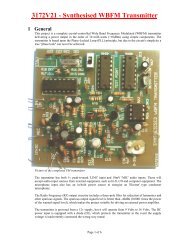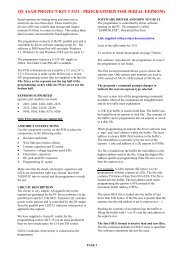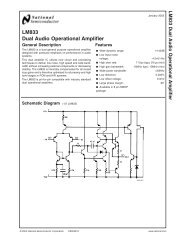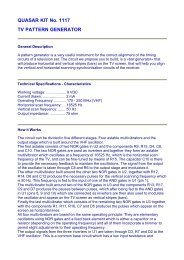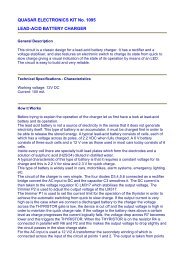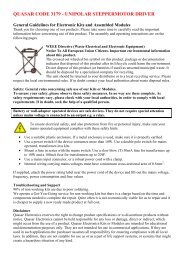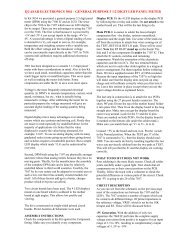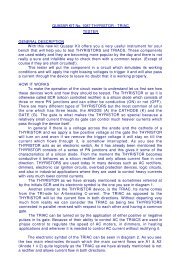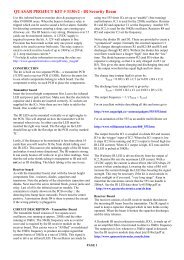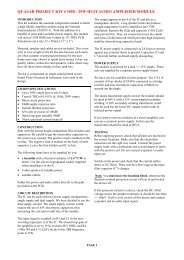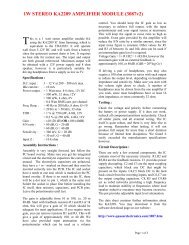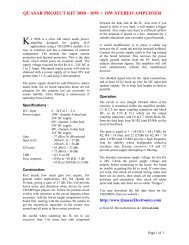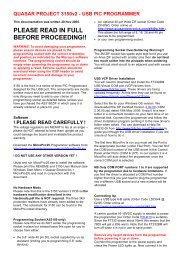QUASAR KIT No. 1008 AF FUNCTION GENERATOR
QUASAR KIT No. 1008 AF FUNCTION GENERATOR
QUASAR KIT No. 1008 AF FUNCTION GENERATOR
You also want an ePaper? Increase the reach of your titles
YUMPU automatically turns print PDFs into web optimized ePapers that Google loves.
<strong>QUASAR</strong> <strong>KIT</strong> <strong>No</strong>. <strong>1008</strong><br />
<strong>AF</strong> <strong>FUNCTION</strong> <strong>GENERATOR</strong><br />
General Description<br />
This is an <strong>AF</strong> function generation covering the frequencies between 25-25,000 Hz in three<br />
bands. It has sine, square and triangular saw tooth outputs and has sufficient output to drive<br />
any amplifier and low distortion to be useful in high precision measurements.<br />
Technical Specifications – Characteristics<br />
Freq. response:... 25-25,000 Hz (three ranges A, B, C)<br />
Range A:..25-250 Hz<br />
Range B:..250-2500Hz<br />
Range C:..2500-25,000 Hz<br />
Distortion:..0.5 % (Max.)<br />
Output voltage:..10 V pp Sine & Triangular<br />
16 V pp Square wave<br />
Output impedance:... 600 ohm<br />
How it Works<br />
The frequency generator uses an IC the TL082 which is a dual op-amp to produce the basic<br />
waveforms. The first of the two op-amps in the IC is used as an oscillator the frequency of<br />
which can be set by means of the potentiometer P2 and its range depends on the value of the<br />
capacitor C3 and is selected by means of S1. The trimmer P1 is used to adjust the duty cycle<br />
of the oscillator. The second op-amp is an integrator which converts the triangular wave form<br />
that is produced by the oscillator to a square one. P4 is used to adjust the amplitude of the<br />
signal. P3 is used to adjust the amplitude of the triangular waveform. The signal from the<br />
output of the oscillator is taken to the circuit built around the two transistors to be converted<br />
from triangular to sinusoidal. The two trimmers P5 and P6 are used to adjust the shape of the<br />
positive and negative portions of the signal for the best symmetry and minimum distortion and<br />
P7 is the potentiometer which adjusts the output level for this waveform. As you see the<br />
circuit consists of fairly basic building blocks with independent adjustments for every one of<br />
them which makes a very versatile and easy to operate instrument. The power supply is also<br />
incorporated on the circuit board and you only have to connect 24 VAC across the rectifier<br />
bridge to make the circuit work.<br />
Construction<br />
First of all let us consider a few basics in building electronic circuits on a printed circuit board.<br />
The board is made of a thin insulating material clad with a thin layer of conductive copper that
is shaped in such a way as to form the necessary conductors between the various<br />
components of the circuit. The use of a properly designed printed circuit board is very<br />
desirable as it speeds construction up considerably and reduces the possibility of making<br />
errors. <strong>QUASAR</strong> Kit boards also come pre-drilled and with the outline of the components and<br />
their identification printed on the component side to make construction easier. To protect the<br />
board during storage from oxidation and assure it gets to you in perfect condition the copper<br />
is tinned during manufacturing and covered with a special varnish that protects it from getting<br />
oxidised and also makes soldering easier. Soldering the components to the board is the only<br />
way to build your circuit and from the way you do it depends greatly your success or failure.<br />
This work is not very difficult and if you stick to a few rules you should have no problems. The<br />
soldering iron that you use must be light and its power should not exceed the 25 Watts. The<br />
tip should be fine and must be kept clean at all times. For this purpose come very handy<br />
specially made sponges that are kept wet and from time to time you can wipe the hot tip on<br />
them to remove all the residues that tend to accumulate on it.<br />
DO NOT file or sandpaper a dirty or worn out tip. If the tip can not be cleaned, replace it.<br />
There are many different types of solder in the market and you should choose a good quality<br />
one that contains the necessary flux in its core, to assure a perfect joint every time.<br />
DO NOT use soldering flux apart from that which is already included in your solder. Too much<br />
flux can cause many problems and is one of the main causes of circuit malfunction. If<br />
nevertheless you have to use extra flux, as it is the case when you have to tin copper wires,<br />
clean it very thoroughly after you finish your work. In order to solder a component correctly<br />
you should do the following:<br />
Clean the component leads with a small piece of emery paper. - Bend them at the correct<br />
distance from the component’s body and insert the component in its place on the board.<br />
You may find sometimes a component with heavier gauge leads than usual, that are too thick<br />
to enter in the holes of the p.c. board. In this case use a mini drill to enlarge the holes slightly.<br />
Do not make the holes too large as this is going to make soldering difficult afterwards.<br />
Take the hot iron and place its tip on the component lead while holding the end of the solder<br />
wire at the point where the lead emerges from the board. The iron tip must touch the lead<br />
slightly above the p.c. board.<br />
When the solder starts to melt and flow wait till it covers evenly the area around the hole and<br />
the flux boils and gets out from underneath the solder. The whole operation should not take<br />
more than 5 seconds. Remove the iron and allow the solder to cool naturally without blowing<br />
on it or moving the component. If everything was done properly the surface of the joint must<br />
have a bright metallic finish and its edges should be smoothly ended on the component lead<br />
and the board track. If the solder looks dull, cracked, or has the shape of a blob then you<br />
have made a dry joint and you should remove the solder (with a pump, or a solder wick) and<br />
redo it.<br />
Take care not to overheat the tracks as it is very easy to lift them from the board and break<br />
them.<br />
When you are soldering a sensitive component it is good practice to hold the lead from the<br />
component side of the board with a pair of long-nose pliers to divert any heat that could<br />
possibly damage the component.<br />
Make sure that you do not use more solder than it is necessary as you are running the risk of<br />
short-circuiting adjacent tracks on the board, especially if they are very close together.<br />
After you finish your work cut off the excess of the component leads and clean the board<br />
thoroughly with a suitable solvent to remove all flux residues that still remain on it.<br />
The function generator is relatively easy to build and if you follow the instructions carefully you
should have no difficulties. The only difficulty you may have is with the components which are<br />
not mounted on the p.c. board namely the potentiometers, the switches and the outlets.<br />
These should be connected with the rest of the circuit with shielded cables which should be<br />
kept as short as possible to avoid introducing noise and distortion to the signal. Building the<br />
circuit from the least sensitive components, to make sure that you don’t damage any<br />
components during soldering. The first components to be soldered should be the pins and the<br />
IC socket. Identify the resistors and solder them one by one in their places. Do the same with<br />
the capacitors taking care to insert the electrolytic the right way round. Solder the trimmers,<br />
the diodes and the transistors taking care not to overheat them. Make a careful visual<br />
inspection of the board to ensure that you have not made any mistakes and then insert<br />
carefully the IC in its socket. Connect the potentiometers, the range selector switch and the<br />
outlets as we described above and the function generator is ready.<br />
Adjustments<br />
If you have an oscilloscope connect the output of the generator to its input, use a 24 V<br />
transformer to supply the generator with power, and adjust the trimmers to get the best<br />
possible shapes on the screen. The potentiometer P1 should be adjusted first, till the square<br />
wave is perfectly adjusted for a 50-50 duty cycle and then by means of P5 and P6 you should<br />
adjust the shape of the sinusoidal waveform till it is as symmetrical and smoothly shaped as<br />
possible. If you do not have an oscilloscope and you only want to use the instrument as a<br />
general purpose audio generator you will not be very wrong if you set the trimmers in their<br />
middle position. However if you do so distortion is likely to be higher and the instrument is no<br />
longer reliable for precision measurements.<br />
Warning<br />
<strong>QUASAR</strong> kits are sold as stand alone training kits.<br />
If they are used as part of a larger assembly and any damage is caused, our company bears<br />
no responsibility.<br />
While using electrical parts, handle power supply and equipment with great care, following<br />
safety standards as described by international specs and regulations.<br />
If it does not work<br />
Check your work for possible dry joints, bridges across adjacent tracks or soldering flux<br />
residues that usually cause problems.<br />
Check again all the external connections to and from the circuit to see if there is a mistake<br />
there.<br />
See that there are no components missing or inserted in the wrong places.<br />
Make sure that all the polarised components have been soldered the right way round.<br />
Make sure that the supply has the correct voltage. Check your project for faulty or damaged<br />
components.<br />
If your project still fails to work, please contact us for information about our Get-You-Going
service.<br />
Schematic Diagram<br />
Parts List<br />
All components including printed circuit board, assembly instructions including schematics<br />
and detailed parts list are supplied when you purchase the kit.<br />
Ordering<br />
For pricing info and online ordering please visit:<br />
http://www.quasarelectronics.com/<strong>1008</strong>.htm<br />
For further info please contact us by e-mail:<br />
mailto: sales@QuasarElectronics.com<br />
COPYRIGHT © 2003 Quasar Electronics Limited. All rights reserved. Reproduction of this document in whole or<br />
in part in any form or medium without express written permission of Quasar Electronics Limited is prohibited.<br />
E&OE



